|
|
|
Sort Order |
|
|
|
Items / Page
|
|
|
|
|
|
|
| Srl | Item |
| 1 |
ID:
094444


|
|
|
|
|
| Publication |
2010.
|
| Summary/Abstract |
Since normalising diplomatic relations in 1972, successive Australian and Chinese governments have focused on deepening trade and investment links to such an extent that China now looms as one of the most critical countries on Australia's twenty-first century horizon. For their part, Chinese elites have welcomed closer ties with Australia and have been particularly keen to accelerate China's direct investment in the Australian mining and energy sectors. Since the early 2000s, a number of commentators have argued that Australia has been gradually drifting towards China's sphere of influence in the Asia-Pacific. This trend, they argue, has been reinforced following the election in 2007 of the Labor party government, which has terminated Australia's involvement in quadrilateral talks with the US, India, and Japan; stepped back from commitments to export uranium to China's long-standing rival, India; and intensified Australia's public criticism of Japanese whaling practices. Meanwhile, in 2008, Prime Minister Kevin Rudd made a point of paying a high profile visit to China during his first major overseas journey, but not matching it with a visit to Japan. Is Australia drifting towards China's strategic orbit in Asia? The article examines this question through the prism of three key indicators of realignment and concludes that, while there is some evidence of Australia accommodating Chinese strategic preferences in Asia, there is no indication that it is realigning itself strategically towards China and away from its long-standing ally, the US.
|
|
|
|
|
|
|
|
|
|
|
|
|
|
|
|
| 2 |
ID:
143681
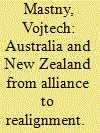

|
|
|
|
|
| Summary/Abstract |
Sino-American debates about the emerging security order in the Asia-Pacific region have not paid enough attention to the perspectives of lesser powers. Among them, Australia and New Zealand, as developed nations increasingly integrated with Asia, are potentially most influential. A historical analysis of their different yet complementary security perceptions and policies suggests diminishing relevance of traditional security structures in the post-Cold War international environment. In the Asia-Pacific region, the established US-centered bilateral alliances are expedient for upholding the status quo, but less so for managing the necessary change. Australia has been at the forefront of promoting the growth of new multilateral regional structures, based on the Association of Southeast Asian Nations (ASEAN), whereas New Zealand has been most successful in developing mutually satisfying relations with China. As desirable strategic partners of both China and the United States, the two middle powers are best suited to promoting a realignment based on common economic interests and values, rather than on balance of power, thus bridging the supposed gap between ‘Asian’ and ‘Western’ values. A Trans-Pacific Partnership including China may eventually become a centerpiece of regional realignment that could serve not only trade but also security by ensuring increasing interaction and understanding among people at all levels―the best safeguard against a slide to military rivalry.
|
|
|
|
|
|
|
|
|
|
|
|
|
|
|
|
| 3 |
ID:
173328
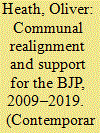

|
|
|
|
|
| Summary/Abstract |
To what extent has the BJP managed to capture the rural vote? And how does the party’s level of support relate to poverty and literacy? Is the Hindu-Muslim divide becoming more pronounced – or has it faded as the party seeks to broaden its appeal? Using constituency level data linked to census data, this article examines support for the BJP and patterns of social realignment at the constituency level from 2009 to 2019. In particular, I examine the impact of social cleavages related to the level of urbanisation, poverty, and literacy within a constituency, as well as its religious and caste profile. Using OLS regression with state-level fixed effects I present a detailed analysis of the social profile of places where the BJP has prospered over the last ten years and the major socio-geographical fault lines that run through the country. The results show that over the last three election cycles support for the BJP has become increasingly polarised along communal lines.
|
|
|
|
|
|
|
|
|
|
|
|
|
|
|
|
| 4 |
ID:
160142


|
|
|
|
|
| Summary/Abstract |
While religious or sectarian divisions in the Middle East do exist, as explanations for regional geopolitics they are mostly misleading.
|
|
|
|
|
|
|
|
|
|
|
|
|
|
|
|
| 5 |
ID:
146899
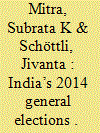

|
|
|
|
|
| Summary/Abstract |
Phrases like “watershed,” “historic,” and “epochal” were used to describe India’s 2014 general election. The Bharatiya Janata Party secured the first single-party majority in three decades, forming the government as the National Democratic Alliance. We argue that the 16th Lok Sabha elections marked a realignment, not a clean break with the past.
|
|
|
|
|
|
|
|
|
|
|
|
|
|
|
|
| 6 |
ID:
120511
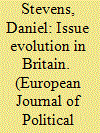

|
|
|
|
|
| Publication |
2013.
|
| Summary/Abstract |
While Carmines and Stimson's work on issue evolutions has prompted research showing the dynamics and effects of new party alignments on abortion, religion, gender and cultural issues, this research has all centred on the United States. This article examines issue evolution in Britain. Using evidence on the timing of changes in elite positions from Comparative Manifestos Group data, and survey data on public attitudes to the European Union with a longer historical sweep than heretofore, the article finds strong evidence that the European issue has followed an issue evolution path, though with distinct dynamics contingent on the pace of elite re-positioning. Thus, this article extends the theory of issue evolution to a parliamentary political system and demonstrates the responsiveness of the public to elite cues, while also providing additional insights from a unique case in which elites have staked out distinct positions not once, but twice.
|
|
|
|
|
|
|
|
|
|
|
|
|
|
|
|
| 7 |
ID:
093897
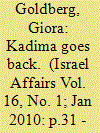

|
|
|
|
|
| Publication |
2010.
|
| Summary/Abstract |
Kadima lost the 2009 elections to the Likud after it had come to power in the 2006 elections. While Kadima only lost one seat (28 instead of 29), and even remained the largest party in the Knesset, it had no chance of remaining in power. Kadima is the most important phenomenon in the Israeli party system in recent years. Despite the fact that it did not win the 2009 elections its influence on the political system has been enormous. After its victory in 2006 Labour and Likud tried to copy it, as happens with every successful product. The best way to relate to Kadima is as a completely different phenomenon, in terms of the standard tools of the historical party map and the traditional division into blocs. This approach denies the former five conceptions of Kadima: a classic centre party, a neo-centrist party, a centrist party in the left bloc, a faction in the Likud or a middle party.
|
|
|
|
|
|
|
|
|
|
|
|
|
|
|
|
| 8 |
ID:
090708
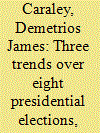

|
|
|
|
|
| Publication |
2009.
|
| Summary/Abstract |
Demetrios James Caraley analyzes three key trends over the last eight presidential elections: the ending of party dealignment but without the emergence of a new majority party coalition, the geographic realignments making the South solid Republican and the Northeast and Pacific coast solid Democratic, and the volatility that has taken place among various politically relevant social and demographic groups. He also discusses whether the election of Barack Obama as president with the simultaneous election of solid Democratic majorities in the House and Senate signal a coming of a new majority Democratic realignment.
|
|
|
|
|
|
|
|
|
|
|
|
|
|
|
|
| 9 |
ID:
155403


|
|
|
|
|
| Summary/Abstract |
The general election of June 2017 revealed a continued tilting of the political axis in England that has been long in the making. This was not a Brexit ‘realignment’—in that the vote is better seen as a symptom of a longer-term divide that is emerging between citizens residing in locations strongly connected to global growth and those who are not. In this analysis, we explore constituency-level patterns of voting in England between 2005 and 2017. Over this period, Labour's vote share has tended to rise in urban areas (that is, major cities), with younger and more diverse and more educated populations often working in ‘cosmopolitan’ industries, whereas the Conservative vote has tended to increase in less densely populated towns and rural areas, with older and less diverse populations. Significantly, Labour has also increased its vote in constituencies with a higher share of ‘precariat’ and emerging service workers—somewhat at odds with characterisation of a party that has lost the ‘left behind’. To the extent that changes in electoral support for the Conservatives and Labour are linked to the Brexit vote, the relationship far predates the referendum vote and should be expected to continue to reshape British politics in future.
|
|
|
|
|
|
|
|
|
|
|
|
|
|
|
|
| 10 |
ID:
181666


|
|
|
|
|
| Summary/Abstract |
What motivates politicians and political parties to shift their positioning on an issue? Focusing on the case of trade policy in countries with advanced economies and plurality electoral systems, I argue that the relative positioning of parties on an existing issue can change even when the preferences of the key actors (voters and politicians) are held constant, and even when party leaders continue to represent the same constituencies. In advanced plurality countries, college-educated voters support free trade, and high-density constituencies are predominantly represented by Left incumbents. As college-educated workers migrate to high-density constituencies in pursuit of higher wages, Left incumbents increasingly embrace free trade, while Right incumbents take more protectionist positions. I provide empirical support for several observable implications of my theory.
|
|
|
|
|
|
|
|
|
|
|
|
|
|
|
|
| 11 |
ID:
187565


|
|
|
|
|
| Summary/Abstract |
The hyper-election period of 2019–21 marked the climax of Benjamin Netanyahu’s rule and with it the transformation of the Israeli party-system. While most commentators read the political situation as personalisation of the ‘Yes Bibi’/‘No Bibi’ polarisation, this article argues that ideological analysis is necessary to understand the dynamics of the four elections and their structural effects. It argues that the dominant issue on the left/right continuum over the past 50 years – the Palestinian-Israeli conflict – gave way to an internal cleavage between Israel’s nature as a ‘Jewish and democratic state’. Netanyahu’s trial only intensified the National Camp’s thesis of the Deep State, accusing the Left, the civil service and the judicial system of being ‘undemocratic’ and condescending of ‘the people’s will’ while the centre-left bloc defended the ‘Jewish and democratic’ Israel, accusing the Right of offering a ‘Halachic state’. Thus, while the Right emphasised the Jewish people, and Netanyahu’s natural partners were the religious and Haredi parties, the centre-left bloc focused on ‘Israel before all’ (to use the newly formed Blue-and-White party’s slogan). Ideological realignment is thus the key to understanding the changes in Israeli party-system.
|
|
|
|
|
|
|
|
|
|
|
|
|
|
|
|
|
|
|
|
|